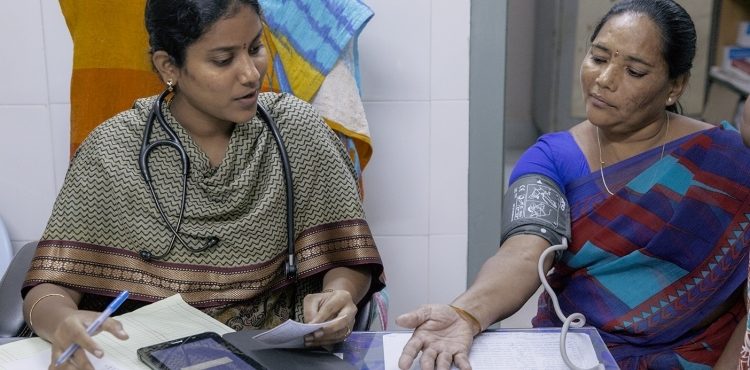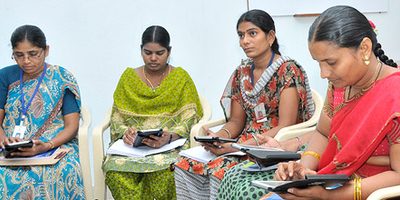
CVD clinics in rural areas: A ray of hope for patients with high risk
Until a community health worker visited the house of Radha of Lankalakoderu village, neither she nor her family members suspected that she was at high risk of cardio-vascular disease. Shyamala, the Accredited Social Health Activist (ASHA) of the village had been going from house to house with a smartphonebased application devised by the George Institute for Global Health that allowed her to screen individuals with high risk of getting heart disease as part of a project called the SMARThealth project. After a few simple questions, taking her weight and measuring her blood pressure, she told the 60-year old that her blood pressure was very high, she was at high risk of having a cardiovascular event and so must visit the primary care doctor immediately.
Dr. Sowjanya, medical officer at the Lankalakoderu Primary Health Care centre saw her in February this year after her regular consultation hours in a special Cardio-Vascular Disease (CVD) clinic that she runs every month as part of the project. She had another tablet with a different version of the SMARThealth app (meant for doctors). She was able to quickly confirm Radha’s high risk status and put her on medication immediately. Assisted by regular prompts from the app, the ASHA worker has been following her up regularly and Radha has made three visits to the doctor since then. The app generates alerts for the ASHA worker and is able to send messages to patients’ phones as well. The result is that Radha’s blood pressure is under control now, and her risk status has improved.
This unique project involving screening of high risk cardiovascular cases followed by consultation with a doctor either at special CVD clinic in the village or at regular PHC center is currently being run in 36 villages as part of a community randomized control trial that is designed to test the effectiveness of this task-sharing mechanism enabled by technology. ``The idea is to deliver good quality affordable health care to as many people as possible by empowering community health workers with the tool that can help them identify high risk patients and then refer them to the doctor,’’ says Dr. David Peiris, Head of Primary Health Care Research at the George Institute for Global Health, Sydney.
Dr. Sowjanya has seen 200 patients at high risk of cardio-vascular disease so far which she would not have been able to do in her normal course at the Primary Health Care Centre. ``We need this kind of focus and I am happy to be a part of this project,’’ she says, adding that patients whom she has seen two to three times are actually showing good results.
The doctor prescribes simple blood pressure medicines after verifying the risk category of each and every individual. ``The real challenge we face is the availability of all kind of medicines at the primary health care centre,’’ she adds.
The project that had started in six PHCs in West Godavari district six months ago is now being extended to six more PHCs. In the final phase, we will be adding six more, says Dr Praveen Devarasetty, Program Head – Primary Health Care at the George Institute for Global Health-India. "This will ultimately help us compare the results in all the villages over time periods when they were part of the project and when they were not,’’ adds Dr Praveen.
This large community-based randomized control intervention is seeking to prove two things. Firstly, that community health workers can work as frontline personnel in a task-sharing mode and that technology can help them do the screening effectively, and second, that doctors can be assisted by an electronic-decision support system in tackling the burden of CVDs in rural areas. ``we call it SMART for Systematic Medical Appraisal, Referral and Treatment,’’ says Praveen, adding that the plan is to systematically extend the framework to other diseases.
ASHA workers are happy to be a part of the project. ``I have referred a large number of high risk cases from my village to the doctor and am following them up regularly. It makes me happy to see that people are actually seeing their blood pressure coming down and the doctors are also placing a great deal of confidence in us,’’ says Devi Reddy of Juvalapalem village, one of the ASHA workers involved in the project.
Arguing that SMARThealth shows the way for transformational health care delivery in a country where there is only one doctor per 30,000 population in rural areas, Dr. Vivekanand Jha, Executive Director of the George Institute for Global Health-India, says: "We are already extending SMARThealth to the field of mental health and diabetes and by spearheading such transformational research, we hope to play a significant part in reducing premature deaths and disability in the country.’’



